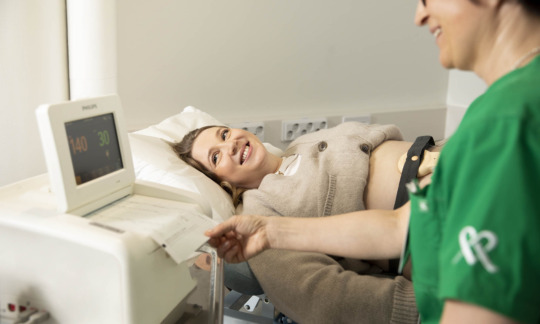Foetal monitoring with KTG and Doppler
The heart rate of the foetus can be monitored and listened to with the help of special monitoring equipment.
Foetal heart beat detected with Doppler
The foetus’s heart rate can be detected with Doppler from pregnancy week 12 onwards. Hearing the heart beat in the early weeks of pregnancy depends on the position of the foetus, the location of the placenta and the thickness of the mother’s abdominal wall.
Heart rate monitoring with Doppler is routinely included in every maternity clinic visit from pregnancy week 12 onwards. Listening to the heart sounds of the foetus can make an early pregnancy more real to the parents. This also ensures that the foetus is alive and that their heart rate is normal, between 120–160 beats per minute.
Felicitas Mehiläinen’s maternity clinic services are also available for only listening to the heartbeat of the foetus if the mother or family is worried about the condition of the foetus. You can contact us through the Felicitas Mehiläinen customer service or you can leave us a contact request.
KTG monitors the foetus’s heart rate and uterine contractions
Cardiotocography, or KTG, is a device for monitoring the foetus’s heart rate and uterine contractions. KTG monitors the foetus’s heart rate, baseline heart rate variation, acceleration or deceleration as well as the frequency, duration and effect of contractions on the foetus’s condition.
As a rule, KTG is used during childbirth either as continuous or periodic monitoring. The maternity clinics of hospitals use KTG devices in addition to an ultrasound examination for more accurate monitoring of the foetus’s health.
Felicitas Mehiläinen’s maternity clinic has a KTG device and, if necessary, a cardiotocograph can be taken during a clinic appointment to monitor the foetus more closely. KTG is typically used as a follow-up method only in the final trimester of pregnancy. You can book an appointment for a KTG monitoring appointment even if you do not have regular appointments at the Felicitas Mehiläinen maternity clinic.
The midwife performs a cardiotocography at the clinic if, for example, the foetus has moved little or the family wants to ensure the well-being of the foetus during the latter stages of pregnancy. If an abnormality is detected in KTG monitoring, we will send the mother to the emergency clinic of a maternity hospital or the maternity outpatient clinic for closer monitoring and further examinations.
At Felicitas Mehiläinen, foetal heart beats and contractions are monitored externally with KTG by attaching plastic sensors to the mother’s abdomen with a flexible belt. The sensors transmit signals to the device, which in turn draws a heart rate and contraction graph on paper. During childbirth, foetal heart rate can be monitored internally, i.e. by attaching a scalp sensor to the foetus’s head.

